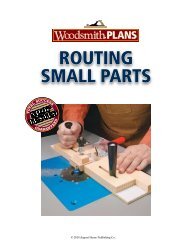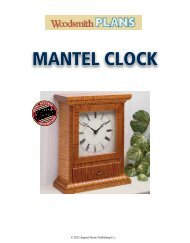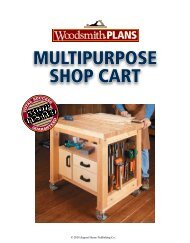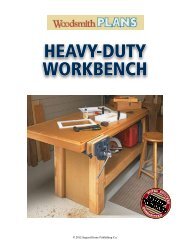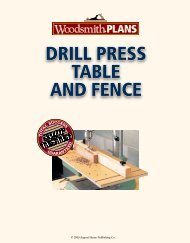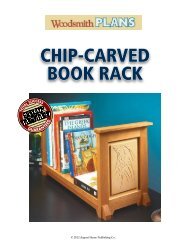SIX-CANDLE CENTERPIECE - Woodsmith Shop
SIX-CANDLE CENTERPIECE - Woodsmith Shop
SIX-CANDLE CENTERPIECE - Woodsmith Shop
You also want an ePaper? Increase the reach of your titles
YUMPU automatically turns print PDFs into web optimized ePapers that Google loves.
six-candlecenterpiece© 2010 August Home Publishing Co.
FeatureProjectSix-Candle CenterpieceYou can build this candle stand in just a few hours using pieces from thescrap bin and a few simple table saw techniques.Making a candle stand is agreat way to use small,prized pieces of figured or exoticwood. The one shown in the photoabove is a good example. It gave methe opportunity to combine a nicepiece of maple I’d been saving withsome shorter cutoffs of cocobolo.Plus, small projects like this oftenoffer a great chance to showcaseyour joinery and finishing skills. Itwill get a lot of scrutiny because itinvites close inspection, so it requiresa lot of attention to detail.Don’t get me wrong, making thiscenterpiece doesn’t involve complicatedjoinery or construction techniques.But it’s the kind of projectwhere even the smallest details— like sanding the end grain of thefeet until it’s almost polished — arevery noticeable. And you’ll find thatspending a little extra time sandingthe finish between coats to get a perfectlysmooth surface will also makea big difference. The result will be awelcome addition to any home.1 www.<strong>Woodsmith</strong>.com © 2010 August Home Publishing Co. All Rights Reserved.
Making the FeetOne of the most notable thingsabout this project is the simplicity ofits design. It’s just a base drilled toaccept six glass candle holders withfour contrasting hardwood feet.As you can see in the drawingsat right, each foot has a 1 1 ⁄ 2 " widedado, which you’ll need to cut it intwo passes at the table saw (details‘c’ and ‘d’). Later, you can plane theblank for the base to fit the dadoes.Cut the Dadoes. In order to make thedado cuts in the feet, I started witha couple of long blanks (detail ‘b’).This way, you’ll have plenty to holdon to when using the miter gauge toguide the workpiece.I attached an auxiliary fence tothe miter gauge to support the cuts.I also glued a piece of sandpaper tothe face of the fence to prevent theblanks from “creeping” out of theirproper position. Then, with the dadoblade set to 3 ⁄ 4 " wide, you can makethe first cut using a 3 ⁄ 4 " spacer blockclamped to the rip fence.Once that’s done, it’s just a matterof rotating the blank end-for-end andrepeating the cut on the other end.Then, remove the spacer block tomake the second cut. This methodguarantees an evenly matched set ofdadoes, exactly 1 1 ⁄ 2 " wide.Completing the feet. With the dadocuts complete, all you need to do iscut the bevel on the ends and cut thefeet to length (box below.)a.c.I started by installing a good crosscutblade on the table saw to get thesmoothest cut possible. Then, I setthe angle to 10° to make the bevelb.d.cut on each end. Finally, you canreturn the blade to 90° and use a stopblock on your auxiliary fence to cutthe feet to length.how-to: cut the feetBevel the Ends. With an auxiliary fence on the miter gauge and astrip of sandpaper on the face to prevent the piece from slipping,cut a 10° bevel on each end of the oversized blank.Cut to Length. Now reset the blade to 90°, and clamp a stopblock to the fence to mark the finished length. The stop blockwill guarantee the feet are cut to the same length.2 www.<strong>Woodsmith</strong>.com © 2010 August Home Publishing Co. All Rights Reserved.
{ It’s a good idea tobuy the glass candleholders of the projectbefore you begin.This way, you cansize the holes for aperfect fit.See howto cut widedadoes usingspacers in thebox on page 2b.a. c.Making the BaseYou can now turn your attention tothe base of the centerpiece. You’llstart with a solid blank, drill holesfor the candles, make the joinery andbevel cuts, and then rip it in half toadd the decorative gap. Two stretchersin dadoes on the bottom of thebase tie the two halves together.Drill the Holes. After you’ve completedjointing and planing the blanksquare, the next step is to drill the sixholes for the candles. To get started,I marked the centerline of theblank. Then I marked the locationof the holes and drilled them using a2"-dia. Forstner bit. If your candlesare a different size, or you don’thave a large Forstner bit, you maywant to try using a router in place ofa Forstner bit at the drill press.Wide Dadoes. With the holes drilled,you’ll need to move to the table sawwith a dado blade installed and set tomake a 3 ⁄ 4 "-wide cut. I used the samesetup to cut the “wrap-around” dadoon the stand as I used for the feet.The box below shows the steps formaking these wide dado cuts.Using an auxiliary fence on themiter gauge and a spacer on the ripfence, you can make the first cut onthe edge of the blank. Then, rotate itto cut the opposite edge. You’ll needto lay the piece flat to cut the bottomdado. Finally, just remove the spacerblock and repeat the cuts on theopposite end of the blank to matchthe 1 1 ⁄ 2 " width of the feet.The Bevel Cuts. Now you’re readyto make the bevel cuts on the endsand sides of the blank. After tiltinghow-to: Make a wide “wrap-around” dadoDado the Edges. With a spacer on the table saw’s rip fence andan auxiliary fence on the miter gauge, set the rip fence to cut thefirst (outside) dadoes in both edges.Cut the Bottom Dado. After cutting both edges, lay the baseflat and cut the bottom dado. To finish the cuts, remove thespacer from the rip fence and repeat the procedure.3 www.<strong>Woodsmith</strong>.com © 2010 August Home Publishing Co. All Rights Reserved.
the blade on the table saw 10°, Imade the cuts on each end. To makethe cuts on the sides, use the sameblade tilt setting. All you need to dois set the rip fence and rip the matchingbevel on each side of the base.Split the Base. With the joinery cut,the holes drilled, and the sides andends beveled, the last step in preparingthe base is to rip it down thecenter. Since you already have thecenterline established from drillingthe candle holes, all you’ll need to dois return the saw blade to 90° andthen make the cut.The Stretchers. Two hardwoodstretchers are screwed to bothhalves of the base to hold themtogether. They fit into the dadoes onthe bottom of the base. You can easilycut them to size at the table saw.Then, you’ll need to drill and countersinkholes for the screws beforemoving on to assembly.Assembly. With all of the partscompleted, the assembly should gopretty smoothly. I started by cuttinga 1 ⁄ 8 "-thick spacer to place betweenthe two halves of the base to holdthem apart. Then, after screwingthe stretchers in place, I fit the legsto the base with glue and clamps.Sand & Finish. As I said earlier, thisproject needs a thorough sandingand a flawless finish. Take extracare to sand the end grain on thebase and legs all the way to 320 grit.a.This yields a smooth finish andbrings out the interesting end grainpatterns. To complement the smoothsurface, I chose to spray the piecewith lacquer. It dries quickly andbuilds up a nice finish in a hurry.The result is a striking piece that’sat home in any setting. Whether youplace it on your dining room table oron the fireplace mantel, this centerpieceis sure to look great.b.Materials & cutting diagramA Feet (4) 1 1 / 2 x 1 1 / 2 - 3 1 / 2B Base (1) 1 1 / 2 x 5 - 23C Stretchers (2) 1 1 / 2 x 1 / 2 - 4(4) #8 x 1" Fh Woodscrews(6) Glass votive candle cups w/candlesshop tip: flat feetFinal Touches. To get the bottoms of the feet perfectlyflat, use some adhesive-backed, 120-grit sandpaper ona flat surface, like your table saw.4 www.<strong>Woodsmith</strong>.com © 2010 August Home Publishing Co. All Rights Reserved.



